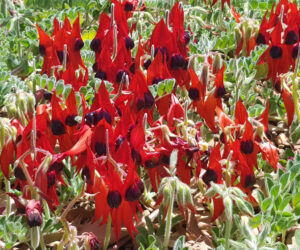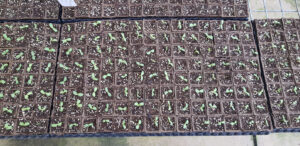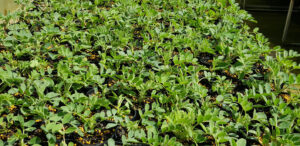
Desert Pea – an arid land beauty
By Matt Coulter
As the state’s floral emblem, Swainsona formosa,the Sturt’s Desert Pea is an important species for the Botanic Gardens and State Herbarium of South Australia to showcase in our collections.
Swainsona formosa, the Sturt’s Desert Pea, was one of the first plants of Australia to be collected by European explorers. English naturalist William Dampier (1651-1715) visited the coastline of Western Australia in 1699 where he collected samples of Sturt’s Desert Pea, which are held in the Fielding-Druce Herbarium at Oxford University. After European colonisation of Australia, further collections of Swainsona formosa were undertaken by John Oxley in New South Wales (1817), Allan Cunningham in Western Australia (1818), Edward John Eyre in South Australia (1839) and Charles Sturt in Central Australia (1844), who is commemorated with the common name of the plant.
The Botanic Gardens and State Herbarium of South Australia has a long association with the Sturt’s Desert Pea. In 1961, the Director at the time, T.R.N. (Noel) Lothian, put forward the application for Sturt’s Desert Pea to be the floral emblem of South Australia. The application was approved and this significant plant has been the state’s floral emblem since.

Over the years the Sturt’s Dessert Pea has been propagated and displayed within the Botanic Gardens collections. In more recent years, a new garden collection of wild-sourced material was developed in front of Adelaide Botanic Garden’s Goodman Building administrative office. The aptly named Rangelands Plaza now contains a prominent display of Swainsona formosa, which typically flower from December through to May each year.
More broadly, the Rangelands Plaza is comprised of seeds of wild-collected origin, sourced by scientists from our South Australian Seed Conservation Centre. This specific seed was collected in 1989, a kilometre north-east of the Roxy Downs township in central South Australia. Trials were initiated to understand the seeds’ viability before a larger amount was germinated for the displays. Each seed is sorted and scarified by creating a ‘nick’ in the seed coat under a microscope. This allows water to penetrate the seed coat and activates the germination process. Without the scarification process, germination is typically poor and uneven. The initial trials indicate that seed viability was still good and was around 70-80% viable, which paved the way to propagating large amounts for our intended displays.
To plant our display, scarified seeds are sown the first week of September, utilising the 112 Jiffy biodegradable propagation system, where single seeds are sown in each tube. This system is used to limit any disturbance to the roots, which is an important process of growing good quality plants for displays. The propagations are held in a non-heated glasshouse where the water management is critical. The first signs of germination are typically observed at about day 5 where the cotyledons push through the media. After 2-3 weeks, the majority of viable seeds will have germinated.

Eight weeks after sowing the seeds, they are ready to be planted (usually around late October) in the final pot size (100mm). The plants are then moved out of the glasshouse and are hardened off growing in the nursery in full sun, where they are watered and given liquid feed regularly. At this stage they grow quickly and develop into good quality plants. In late November, after growing in the nursery for four weeks, the plants have developed a good solid root system and have a balanced vegetative growth. They are then ready to be planted out in the collections beds. The most important factor in planting out, is that the roots are not disturbed and the soil has excellent drainage. Soils that hold excessive moisture will result in the death of the plants.
From here, the first flowers will appear in early December and will continue with lots of flowers right through to about May. In some instances, they can flower into winter. The displays are treated as an annual display, and as winter sets in and as the plants start to deteriorate, they are removed.
As the state’s floral emblem, Swainsona formosa is an important species for the Botanic Gardens and State Herbarium to showcase in our collections. It is an incredibly unique and beautiful species. In addition to growing Swainsona formosa a range of other Swainsona species are grown including S. swainsonioides, S. stipularis, S. phacoides, S.greyana, S. galegifolia and importantly, S. dictyocarpa, an endemic endangered species, which we have been involved in through collecting seed and propagating of this rare pea. In the coming years we hope to add other endemic species to the collection and to continue to promote our wonderful state floral emblem.
Matt Coulter
Senior Horticultural Curator, Nursery
Botanic Gardens and State Herbarium (South Australia)
E: matt.coulter@sa.gov.au
www.botanicgardens.sa.gov.au/science-conservation/state-herbarium
Main photo: Swainsona formosa in full flower at Adelaide Botanic Garden (Image: Matt Coulter)
